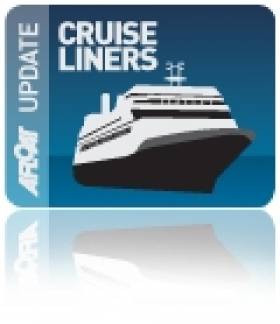Displaying items by tag: Swan Hunter
A Classic Double Act: From General Cargoships to Cruise Liners
#CARGO TO CRUISELINERS – This morning saw the arrival of World Cruises Agency,'s Princess Daphne to Dublin Port, the veteran vessel built in 1955 was originally launched as a cargoship, writes Jehan Ashmore.
The 18,833grt cruiseship had arrived into Dublin Bay from Falmouth, however her cruise embarkation port was from Portsmouth, where World Cruises started their inaugural cruise call to Ireland. Yet again another newcomer operating in Irish waters this season.
In recent years Princess Daphne and her sister Princess Danae, have operated for Classic Cruises International (CIC), and they were among a fleet of older tonnage.
Before she became Princess Daphne, she was commissioned for Port Line (subsidiary of Cunard Line) and was built at the shipyard of Swan Hunter on Newcastle-upon-Tyne and launched as Port Sydney. She was joined by her sister Port Melbourne, also completed in the same year but built by Harland & Wolff. They were ordered to serve the UK route to New Zealand, Australia via the Panama Canal.
The handsome looking general cargoships or 'reefers' (handling meat exports) had a large superstructure, with accommodation for 12 passengers. Noting the wraparound passenger veranda deck and six cargo-holds accompanied by derricks for self-unloading.
Conversion work took place in 1975 and again this applied to her sister the following year. The rebuild included replacing the old superstructure with a large longer streamlined superstructure, noting fore-ward of the bridge are the derricks that was incorporated during the work. This feature does not apply to Princess Danae which has an extended structure instead.
They retain their have deep-drafted (7.9m) hulls, complete with many portholes along sheer classic lines. Princess Daphne has a hull length of 162.39m which is marginally longer then her sister's 162.31m.
Over their respective career spanning nearly six decades, they have operated for several owners and under different names, however their current names have remained for some time. The pair are both Portuguese flagged and operated by World Cruises based in Lisbon.
Incidentally Princess Danae (1955/16,531grt) will be making a call to Dublin Port tomorrow, as she is scheduled to arrive at her birthplace in Belfast Harbour today. Also in port, is Plantours & Partners Cruises Hamburg, which had sailed overnight from Dublin Port, as previously reported on Afloat.ie.
Lecture: 'The Kowloon Bridge & Her Sisters'
The Stella Maris Seafarers' Club, Beresford Place, is located beside Busaras and faces opposite the rear of the Customs House. Nearby is the Irish Life Center (ILAC) which is convenient for car-parking and buses, the 'Red' Luas (Busaras stop) and DART stops at Connolly /Tara St. stations. All are welcome, bar and refreshments and a voluntary contribution is appreciated.
For further information about lectures and updates on the M.I.I's maritime museum located in the Mariners Church, Dun Laoghaire log on to www.mariner.ie. The museum which is due to reopen this year are looking for volunteers to help, for further details click here.
Royal Navy Anti-Piracy Frigate Visits Dublin Port
The Royal Navy's Type 22 frigate HMS Chatham (F87) which recently returned to UK waters after a seven month deployment on anti-piracy duties off Somalia, visited Dublin Port last weekend, writes Jehan Ashmore.
HMS Chatham was the lead vessel for NATO's 'Operation Ocean Shield' as part of a multi-national task force in the seas off the African state that in recent years has become notorious for piracy.

HMS Chatham departs Dublin Bay and the rocks off Dalkey Island. Photo: Jehan Ashmore /ShipSNAPS
The frigate departed Dublin on Monday afternoon and set an easterly course off the Baily Lighthouse, but surprisingly the 5,300 tonnes vessel returned into the bay. HMS Chatham then crossed the bay towards Sandycove. From there the 148m vessel which has a draft of 6.7m veered in a south-easterly direction, to sweep past off the rocky outcrop, to the north of Dalkey Island and continued southbound off The Muglins.
In mid-November the frigate visited her namesake port on the Medway to mark the 20th anniversary since the vessel's commissioning at Chatham in 1990. The occasion was also the first time that such an event had taken place outside a Royal Navy establishment.
Built in 1988, the vessel was launched from the Swan Hunter shipyard on the Tyne and is normally based in her homeport of Devonport, Plymouth.






























































